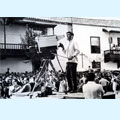TELEVISION.
 This powerful medium was introduced to the archipelago in 1964, when in Gran Canaria the first black and white images appeared in around one hundred existing television sets in the two large island capitals. In the first year the number jumped to some 10 000.
This powerful medium was introduced to the archipelago in 1964, when in Gran Canaria the first black and white images appeared in around one hundred existing television sets in the two large island capitals. In the first year the number jumped to some 10 000.
The first signals of Spanish Television (Televisión Española) were broadcast and with them the fist news programme, which was aired one day late, because the reels were transported by airfare.
By the year 1970 some 1 800 programming hours were being taped nationally, broadcasting to almost 350 000 sets. The influence of this medium grew very rapidly.
 By the next year the image quality was greatly improved with the addition of the satellite signal. The arrival of colour came with the broadcast of the Olympic Games of Munich ’72 and by the end of the XX century the so called autonomous television, later on named Televisión Canaria, was introduced, granting a wish which had been conceived almost two decades earlier.
By the next year the image quality was greatly improved with the addition of the satellite signal. The arrival of colour came with the broadcast of the Olympic Games of Munich ’72 and by the end of the XX century the so called autonomous television, later on named Televisión Canaria, was introduced, granting a wish which had been conceived almost two decades earlier.
This is a brief history of a very appreciated medium on all the islands.